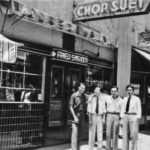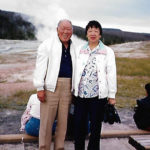Long before there was Panda Express or PF Chang’s, there was Chungking Cafe in Riverside, Bing’s Cathay Inn in San Bernardino, the Great Wall in West Covina, Kun Ming Kitchen in Covina, Lotus Garden in Downey, Yangtze Restaurant in Ontario, Calif., and Nam’s in San Gabriel. All were owned and operated by natives of Gom Benn Village.
It took decades of hard work. The first of the Gom Benn immigrants may have come to America after the Gold Rush. Or during the building of the western railroads. They came for low-pay jobs, as domestic servants cleaning and cooking. Others worked as merchants, traders, grocers and restaurant workers. Some found jobs in farms and orchards. Jobs were hard to get, because the Chinese were the most hated of the immigrants.
The Chinese faced the first U.S. laws blocking an entire ethnic class of laborers. Chinese women were barred from coming to America in 1875, men prohibited under the Chinese Exclusion Act in 1882 — unless the men already had relatives here. Still, China was so poor, that men continued to come, by pretending to be “paper sons.”
For generations, Chinese laborers faced discrimination and even violence. Yet, a few eventually prospered. The secret was the invention of “chop suey” — a made-in-America concoction of stir-fried meat and vegetables.
Chinese-operated chop suey joints became popular at the turn of the 20th century. Americans came for an exotic, hip experience, and stayed for the chop suey, chow mein, sweet and sour pork and fortune cookies. Over the decades, the popularity of Chinese food would grow as chop suey joints spread to small town America.
Bing S. Wong 黄植礼, one of the founders of the Gom Benn Scholarship Fund, came to America at the age of 13, with his father, in 1922. By 1933, he was operating his first restaurant in Calexico (on the U.S. border with Mexico).
After World World II, when restrictions against the Chinese eased, and women were allowed to come, Bing Wong brought his wife, Ting F. Wong, to America. In 1956, they opened Bing’s Famous Cathay Inn in San Bernardino, and operated it for 35 years. More than a decade after it was sold, the San Bernardino Sun newspaper quoted a former diner who recalled fondly in 2011, “There always was a wait at Bing’s Cathay Inn on Highland Avenue. It was one of San Bernardino’s fanciest restaurants back in the day, and owner Bing Wong was among the city’s great civic leaders and philanthropists.”
Voy Wong 景回(烠) and Fay Hing Lee Wong were owners of downtown Riverside’s Chungking Restaurant on Market Street near University Avenue. In 1942, Voy opened the Chungking restaurant in Riverside with several partners, including his older brother Poy Wong 黄景培, and Bing T. Wong 黄柏旋 and Harold Wong黄礼逊, also from Gom Benn.

They bought the cafe from a Japanese-American who had to sell, when Japanese Americans were moved to internment camps. After the war, Voy returned to China to bring Fay to the United States in 1947. Former Riverside Mayor, Bill Evans, picked up the reunited couple in San Francisco when their ship docked and drove them back to Riverside.
Voy and Fay had five children, Ellen, Don, Janlee, Linda, and Julie. The children helped out at the restaurant. Chungking became a favorite lunch spot for the mayor and civic leaders. After selling the Chungking Restaurant in 1974, Voy passed away a year later.
After World War II, Harold Wong would go on to open a South Bay laundromat, and Bing T. Wong and his wife Boy Jin would open a grocery store, and then the Great Wall Restaurant in West Covina in 1955.
It was a time when suburbia was booming. By the mid-1960s, Bing T. and Boy Jin expanded the Great Wall, and it became one of the most popular gathering places in the region.
Decades later, after the restaurant closed in 2001, a longtime customer recalled, “For half-a-century, the Great Wall in West Covina served the best Cantonese Chinese food in the San Gabriel Valley. I still remember our order by heart: 2 orders of bacon-wrapped shrimp (always), also perhaps with two orders of barbecued pork, or two orders of paper-wrapped chicken .. a large bowl of wonton soup, mun yee mein, Chinese peas with beef, and, my absolute favorite, two bowls of PORK FRIED RICE! I’d eat almost a whole bowl myself!”
Bing T. Wong’s brother, Bing K. Wong 黄柏宗, worked briefly at the Great Wall. Then used a similar menu in opening a take-out eatery, Kun Ming Kitchen, in 1955, across the 10 Freeway, in Covina.
Unlike the sit-down restaurants, it featured fast food. The same car culture that abetted the growth of suburbia drove a boom in Chinese fast food taken home in iconic white folded cardboard cartons. Bing K. Wong would operate Kun Ming Kitchen for 25 years.
In 1957, Gim Hong Lee, whose wife Sun Woo came from Gom Benn, opened the first Chinese restaurant in Downey. The Lotus Garden was notable not only for its food, but also for a design.
It’s architect was Gin D. Wong, who was born in Guangzhou, China, and came to America as a child. He became world famous with structures such as the futuristic LAX Theme Building, and the Union 76 gas station in Beverly Hills with a sweeping canopy that resembles an alien spaceship. The Los Angeles Conservancy described the gas station as “a true icon of Mid-Century Modernism, recognized everywhere as one of the highest examples of Googie architecture in the world.”
Gim Hong Lee operated his stylish Lotus Garden restaurant for 24 years. A few years after his death in 2008, his wife, Sun Woo, created the Gim Hong Lee Memorial Scholarship with a donation of $10,000 to help a top graduate student.
Perhaps the longest operated of the Gom Benn restaurant was the Yangtze, opened in 1961 by Raymond Gin 黄荣高, of Gom Benn, and his wife Edna.
The family operated the restaurant and bar for 54 years.
“On weekends the whole place would be packed. People would be standing with drinks in their hands waiting for a table,” Edna Gin told the Daily Bulletin newspaper in 2015, after she announced the restaurant would close. “Everybody was shopping downtown on a Friday,” she recalled. “It was really nice. After the mall opened in Montclair (in 1968), things started quieting down. After Ontario Mills opened (in 1996), everybody went over there.”
Times changed. Panda Express opened its first restaurant in 1983. New waves of Chinese immigrants came to America beginning in the 1970s, opening more “authentic” Chinese restaurants in the San Gabriel Valley and elsewhere.
Today, according to the Chinese American Restaurant Association, there are 40,000 Chinese restaurants in the United States — more than all the McDonald’s, KFCs, Pizza Huts, Taco Bells and Wendy’s combined.









Thank you for this great article! I remember going to “Uncle Bing’s” restaurant as a child. My father, Gin D. Wong, grew up in the Gom Benn village and yes, he was the architect who designed the famous gas station, was head of the design team that created LAX, and was president of the firm that designed the famous Pyramid building in San Francisco.
I’m so happy to find this site! Thank you so much.
Janna Wong Healy
Bing and Ting were two of the most wonderful people I ever met. As a child, I ate at Bings Cathay Inn every single Wednesday as my father ‘s restaurant was closed on Wednesdays. Back then you dressed up to go out to dinner. I remember Ting’s beautiful dresses, her hair and how beautiful she was. Bing would take me into the kitchen and give me tempura fried shrimp to snack on while our dinner was being prepared. I shall always remember their beauty, kindness, generosity, philanthropy, and food. I was so happy when we voted on the name of the Bing Wong Elementary school. They truly meant a lot to me.
Thank you for this historical account of all the Chinese restaurants started by the GomBenn pioneers. My parents were Voy and Fay Wong so my siblings and I grew up around these people. We had talked about documenting all the GomBenn restaurants, but through the work of the architect, Gin D. Wong, as he had designed the remodeled Chungking Restaurant in the 1960s and I believe most of the other restaurants too.
So I was pleased to to read that you had accomplished more than that with personalized stories of each family.
Linda W. Huang
Pingback: The Butcher’s Wish for His Secret Child - Gom Benn Scholarship Fund
Pingback: Part 8: Fay Wong’s Proverbs - Gom Benn Scholarship Fund